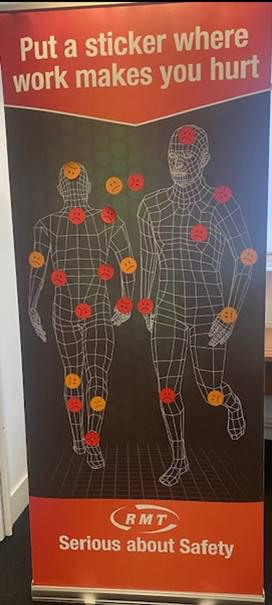
2 minute read
RMT Cleaners’ Health and Safety
The RMT body was out and about at a recent London Transport Regional Council cleaners’ organising event, where a workshop activity on body mapping encouraged cleaners to speak about their aches and pains caused by work, which was mainly in their shoulders, back and knees as a result of carrying multiple bags of rubbish full of discarded free newspapers, up and down stairs at stations where lifts where not available.
To accompany this activity an RMT cleaner’s H&S advice document was distributed: https://www.rmt.org.uk/about/ health-and-safety/cleaners-healthand-safety-advice/
Advertisement
Body mapping is a great way of getting members talking about the impact on their work on their health and safety, and when run as a group activity it can show that work related health issues are often collective problems.

Body mapping can be simple to do and there is lots of information available about how to do this. More info can be found at www.hazards.org/diyresearch/
Vibration
RMT’s National Bus Workers’ Industrial Organising Conference last year passed a resolution on wholebody vibration which noted that whole-body vibration can cause fatigue, stomach problems, headache, and loss of balance and “shakiness” and that exposure over a number of years, whole-body vibration can affect the entire body and result in a number of health disorders. It went on to note that drivers - due to occupational exposure to whole-body vibration - could develop a number of circulatory issues such as bowel, respiratory, muscular and back disorders. Whole-body vibration (WBV) being the possible causes for these disorders. Problems can be encountered by workers who spends a lot of time in a vehicle (bus, taxi, tamping machine, etc.) who are likely to experience aches and pains. The term “repetitive driving injury” (RDI) has been used where vibration is transmitted through the feet or through the seat of the vehicle. Large jolts while driving can also cause health risks including back pain. For women who are pregnant, WBV increases the risk of back pain and it can also be potentially hazardous for the unborn child.
There are two types of vibration that occur in the workplace: these are hand-arm vibration and whole-body vibration. Employers are required by law, to assess and identify measures to eliminate or reduce risks from exposure to vibration. If the risk of vibration has been identified, and removal of risk is not an option, then control measures must be put in place. Information and training must also be provided, along with regular health surveillance.
Employers must comply with the Control of Vibration at Work Regs 2005 and they should follow HSE’s guidance. This will help manage the risk of symptoms resulting from vibration.
An example of whole-body vibration impacting a
RMT member and successful claim for compensation can be found at bit.ly/3Wa5lGw
To make vibration injury claims see bit.ly/3pHFVnG
See UK Government Industrial Injuries Disablement Benefits: technical guidance at bit.ly/452meqU for more information on industrial diseases.




